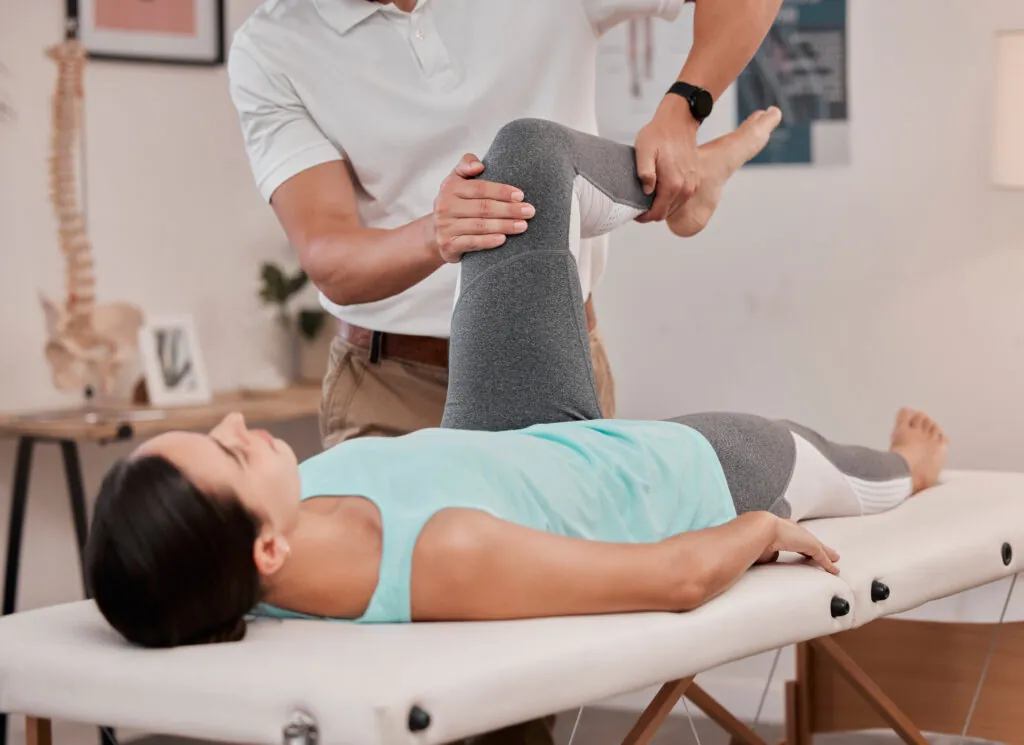[tsf_breadcrumb sep="/" class="breadcrumbs]
Home / Patients / Specialty Services / Pelvic Health
Pelvic pain or dysfunction can feel isolating, but you don’t have to go through it alone. We specialize in treating a variety of pelvic issues, from pregnancy-related conditions to pelvic floor dysfunction. Our therapists work with you in a private, compassionate environment, helping you feel comfortable and supported. Together, we’ll develop a personalized program that focuses on relieving your pain, improving function, and restoring your confidence. No matter your age or condition, we believe you deserve relief—and we’re here to help you find it.
Your pelvic floor consists of a group of muscles that span the bottom of your pelvis. These muscles contract and relax like other muscles in your body, but their range of motion is much smaller. They support your pelvic organs, including the bladder and bowels, and assist with essential bodily functions like urination and passing a bowel movement.
When the muscles of the pelvis aren’t functioning correctly, it can lead to problems like incontinence, pelvic pain, or pain during sex. Pelvic floor therapy is a type of physical therapy that targets the muscles of the pelvic floor to address symptoms of pelvic floor dysfunction.
Pelvic floor dysfunction is more common than you may think. Up to 32% of women have experienced at least one symptom of pelvic floor dysfunction, or pfd.1 While more focus is generally placed upon women with this condition, 16% of men have also been identified with PFD symptoms.2
You may not be aware of your pelvic health on a daily basis, but your pelvic floor plays a key role in supporting your internal organs and helping you perform essential bodily functions. Depending on the severity of your PFD, your symptoms can significantly affect your quality of life and overall health.
Physical therapy for pelvic floor dysfunction can help prevent, treat or manage your symptoms. With Direct Access, you can call today to get started with an experienced pelvic floor physical therapist. Keep reading to learn more about how pelvic floor physical therapy can help you.

Common symptoms of pelvic floor dysfunction can include:
It is important to discuss your symptoms openly with your physical therapist so they can build an individualized PFD treatment plan. Sometimes these symptoms can be difficult to talk about, but just know that your physical therapist is there to support you.
Contact your physical therapist if you’ve been experiencing urinary or fecal incontinence, pelvic pain, or any of the symptoms listed above. You can also talk to your physical therapist if you have any of the associated risk factors listed earlier in this article. Your physical therapist can help you determine the need for a screening.
You don’t need a referral to see a physical therapist. Direct Access allows you to call and schedule an appointment with one of our experienced pelvic floor physical therapists today.
At your initial evaluation (first physical therapy appointment), your physical therapist will begin by taking a thorough medical history and reviewing your symptoms and complaints. After gathering this information, they will begin your physical examination.
The physical examination consists of two components, the external and internal exams. During the external examination, your physical therapist will assess your pelvic region, including your lower back, glutes, and core for strength, pain and tenderness. Your physical therapist will also conduct a functional screening to rule out other contributing factors to your pelvic symptoms.
During the internal examination, your physical therapist will assess your pelvic floor directly. This involves your physical therapist using gloved fingers to palpate the muscles of the pelvic floor while performing voluntary contractions/relaxations.
Your physical therapist may also use a biofeedback device to monitor your pelvic floor muscle activity. The machine provides auditory or visual cues to help you become more aware of your pelvic floor and improve your voluntary control of these muscles.
If needed, your physical therapist will refer you to your doctor for further diagnostic imaging, like an ultrasound.

Pelvic floor pain can significantly affect your daily life. Talk to your physical therapist about your pelvic pain and symptoms. A personalized treatment plan is essential to your success and long-term pelvic health.
If you have questions or concerns about your pelvic floor symptoms, call today to book a consultation with an experienced pelvic floor physical therapist. They will provide professional guidance and support to treat and manage your pelvic floor dysfunction.
There are many positive outcomes you can achieve with pelvic floor physical therapy:
Pelvic floor physical therapy can also provide guidance and support for pregnant and postpartum women.
Your pelvic floor treatment session may include some of the following physical therapy techniques, exercises and/or modalities:
The goals of pelvic floor physical therapy sessions will vary based on each patient. Your physical therapist will help you determine your therapy goals, which typically include pain reduction and symptom management.

Our staff can help pain you with an experienced pelvic floor physical therapist to fit your needs. Pelvic floor physical therapists will frequently have received additional training regarding pelvic floor dysfunction and associated treatments. Call us with your questions—you don’t need a referral to make an appointment.
The partnership between you and your therapist, also called the therapeutic alliance, is extremely important for your success in pelvic floor physical therapy. While some of the symptoms of PFD can be difficult to talk about, it’s essential to maintain open communication with your physical therapist to ensure the best treatment. Take an active role in your rehabilitation, ask questions, and commit to your exercise prescription to see the best results. Your physical therapist is there to encourage and empower you to reach your therapy goals and take ownership of your pelvic health.
Physical therapy for pelvic pain is a proven, effective treatment for pelvic floor dysfunction. Your experienced physical therapist will guide you through a specialized program designed to treat and manage your pelvic floor symptoms. Using a combination of pelvic floor therapy exercises and other treatment techniques, your physical therapist can help you find relief from your pelvic pain and symptoms.
Call to book a consultation with one of our pelvic floor physical therapists. With Direct Access, you don’t need a referral to be seen. Contact us today and our helpful staff will answer any questions and get you started on your path to pelvic health.
Sessions are conducted in private rooms, ensuring confidentiality and comfort during treatment.
Yes, specific pelvic floor exercises can help manage and reduce the symptoms of prolapse.
Yes, these are commonly treated issues associated with pelvic PT.
People of all genders and ages can have PFD. However, it is more commonly associated with females, especially in regards to childbirth and menopause.
PFD exercises focus on strengthening and improving control of the pelvic floor muscles. Your physical therapist will determine the best exercises for you, but commonly prescribed exercises include Kegels, bridges, squats and diaphragmatic breathing.
Pelvic floor therapy is a type of physical therapy that uses targeted exercises and other treatment techniques to strengthen or relax the muscles of the pelvic floor and improve your control over these muscles.
Some pelvic floor dysfunction risk factors, like age, cannot be avoided. However, there are many ways to reduce your risk of developing PFD. These include physical activity, maintaining a healthy body weight and quitting smoking.